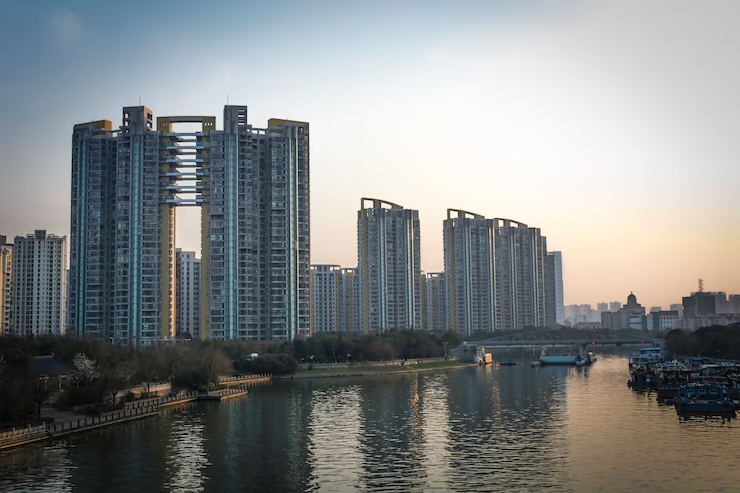Understanding the intricacies of location analysis, customer demographics, and competition assessment can be the difference between success and struggle.
Stay tuned to discover the top 10 tips that will guide you in selecting the perfect retail space to turn your dream into a flourishing business.

Key Takeaways
- Analyze market trends and demographics for strategic location decisions.
- Study competition to differentiate and position the retail space effectively.
- Prioritize accessibility, parking, and design to enhance customer experience.
- Build positive landlord relations and reflect brand values in space aesthetics.
Location Analysis
When selecting a retail space, consider the location carefully to guarantee business success. Analyzing market trends and location advantages is important to make sure that your store thrives. Look for areas experiencing growth in your target market or industries that align with your products. Understanding the market trends will give you a competitive edge and help you cater to the needs of your potential customers effectively.
Another essential aspect to think about is the level of foot traffic in the area. Higher foot traffic usually translates to more potential customers walking by your store. Additionally, assess the transportation options available around the location. Easy access to public transportation or ample parking spaces can have a big impact on the number of visitors your store receives.
Choosing a location with location advantages can also give you a competitive edge. Look for areas with complementary businesses or where your target demographic frequently visits. Being situated near businesses that attract similar customers can help drive more foot traffic to your store. In addition, consider the visibility of the location and its proximity to popular attractions or landmarks.
Customer Demographics

Consider the customer demographics in the area when selecting a retail space to guarantee alignment with your target market and maximize business potential. Understanding the population’s characteristics, preferences, and consumer behavior in the vicinity of your potential retail space is important for tailoring your offerings to meet their needs effectively.
Analyzing the target market’s demographics involves looking at factors such as age, gender, income levels, and family composition. For instance, if your target market consists mainly of young professionals, choosing a retail space near business districts or trendy neighborhoods could be beneficial. On the other hand, if families with children are your primary customers, a location close to schools or residential areas might be more suitable.
Consumer behavior plays a significant role in determining the success of your retail space. By studying how customers in the area shop, what influences their purchasing decisions, and what they value in a shopping experience, you can adapt your store layout, product offerings, and marketing strategies to better appeal to them.
Incorporating these insights into your retail space selection process can give you a competitive edge and enhance your business’s chances of success. By aligning your location with your target market and understanding consumer behavior, you can create a shopping environment that resonates with your customers and fosters loyalty and repeat business.
Competition Assessment
To assess the competition effectively and make informed decisions about your retail space selection, it’s important to conduct a thorough evaluation of the existing businesses in the area. Start by conducting market research to understand the types of businesses operating nearby, their target markets, pricing strategies, and overall popularity. This information can provide valuable insights into the competitive landscape and help you position your retail space accordingly.
Important pricing is a vital aspect of competition assessment. Analyze the pricing strategies of your competitors to determine if there’s room for your business to offer competitive pricing or if you can differentiate through premium pricing strategies. Understanding how your competitors price their products or services can help you identify gaps or opportunities in the market that you can leverage to attract customers.
Accessibility and Parking
For best success in selecting a retail space, prioritize evaluating the accessibility and parking options available at potential locations. Ensuring easy access for your customers is essential for driving foot traffic and sales to your store. When prioritizing accessibility, look for locations near public transportation hubs to attract customers who rely on buses, subways, or trains. Providing convenient access to public transportation can greatly increase the number of visitors to your store. Additionally, offering valet parking services can enhance the overall shopping experience for customers who prefer to drive.
Parking is another critical aspect to prioritize when choosing a retail space. Having a dedicated parking lot or access to nearby parking facilities can make it convenient for customers to visit your store. Adequate parking spaces guarantee that customers can easily find a place to park, encouraging them to stay longer and explore your offerings. Furthermore, if your business involves frequent deliveries or shipments, having a loading dock can streamline operations and improve efficiency.
Incorporating elements like color schemes, lighting, and decor that align with your brand identity can enhance the overall atmosphere of your store. Design aesthetics play an important role in shaping the perception of your business and influencing customers’ purchasing decisions. By paying attention to the visual aspects of your retail space, you can create a memorable and inviting setting that encourages customers to explore and engage with your products.
In addition to design aesthetics, it’s important to prioritize space functionality when planning the layout of your retail space. Consider factors such as traffic flow, product placement, and accessibility to make a seamless shopping experience for your customers. A well-designed and functional space can improve customer satisfaction and drive sales by making it easy for shoppers to navigate your store and find what they’re looking for. By striking a balance between design aesthetics and space functionality, you can create a retail environment that attracts customers and keeps them coming back for more.
Space Layout and Design

Exploring the layout and design of your retail space holds the key to creating a welcoming and engaging environment for your customers. When considering the design aesthetics of your retail space, think about how you can visually represent your brand and create a cohesive look that resonates with your target audience. Choosing a design that reflects your brand’s values and appeals to your customers’ preferences can help establish a strong connection and foster a sense of belonging.
Lease Terms and Negotiation

When considering leasing terms and negotiation for your retail space, it’s essential to thoroughly understand the contract details to make sure a mutually beneficial agreement. Negotiation strategies play a pivotal role in securing favorable lease terms that align with your business goals.
Here are three key points to keep in mind during the negotiation process:
- Conduct Research: Before entering into lease negotiations, conduct thorough research on comparable rental rates in the area. Understanding market trends and prices will empower you to negotiate from an informed position, potentially leading to more favorable lease terms.
- Flexibility is Key: While it’s important to have clear objectives in mind, being flexible during negotiations can open up opportunities for compromise. Consider alternative lease structures or concessions that could benefit both parties and lead to a more collaborative agreement.
- Seek Professional Assistance: Engaging a real estate attorney or a commercial real estate agent with experience in lease negotiations can provide valuable insights and guidance. These professionals can help navigate complex lease terms, identify potential pitfalls, and make sure that the final agreement is fair and advantageous to you.
Landlord Reputation

Understanding your potential landlord’s reputation is essential when selecting a retail space for your business. A landlord with a positive reputation can make a significant difference in your overall experience as a tenant. When evaluating a landlord, pay attention to their tenant relationships and property maintenance practices.
A reputable landlord values strong tenant relationships. They communicate effectively, respond promptly to concerns, and work collaboratively to address any issues that may arise. By fostering a positive relationship with their tenants, a landlord creates a sense of trust and mutual respect, which can lead to a more harmonious rental experience. Before committing to a lease, consider reaching out to current tenants to inquire about their experiences with the landlord. This firsthand feedback can provide valuable insights into what it may be like to rent from them.
Property maintenance is another critical aspect of a landlord’s reputation. A reputable landlord takes pride in maintaining their properties to a high standard. Regular upkeep, timely repairs, and a clean environment demonstrate their commitment to providing a quality space for their tenants. On the other hand, a landlord who neglects property maintenance can create frustration and inconvenience for tenants. Prioritize landlords who prioritize property maintenance to guarantee a comfortable and professional setting for your business.
Future Growth Potential

To maximize the long-term success of your retail business, evaluating the future growth potential of a prospective location is vital. When considering the future growth potential of a retail space, it’s essential to assess various factors that can impact your business in the long run.
Here are three essential points to focus on:
- Market Trends and Development: Stay informed about the market trends in the area where you plan to establish your retail space. Understanding how the market is evolving and what developments are on the horizon can help you anticipate opportunities or challenges that may arise.
- Expansion Opportunities: Look for retail spaces that offer room for expansion. Having the flexibility to grow your business within the same location can save you time and resources in the future. Consider whether the layout and size of the space can accommodate your potential growth needs.
- Projections: Analyze future projections for the area, such as population growth, economic forecasts, and upcoming infrastructure projects. These projections can give you insights into the potential customer base, market demand, and overall business environment that you’d be operating in.
Budget and Cost Considerations
When selecting a retail space, it’s vital to examine cost-effective location options that align with your budget. Conducting a financial feasibility assessment can help you determine if a specific space fits within your financial parameters.
Implementing effective expense management strategies will also be key in ensuring the long-term financial sustainability of your retail operation.
Cost-Effective Location Options
Considering your budget and cost considerations, finding a cost-effective location for your retail space is essential for maximizing profitability. To help you make the right choice, here are some tips:
- Look for Affordable Options: Seek out locations that offer reasonable rental rates or purchase prices to keep your overheads in check.
- Focus on Strategic Positioning: Choose a location that aligns with your target market and provides easy access for customers.
- Consider Hidden Gems: Explore upcoming neighborhoods or mixed-use developments for potential cost savings and future growth opportunities.
Financial Feasibility Assessment
As you analyze the financial feasibility of your retail space selection, evaluating your budget and cost considerations is paramount for making informed decisions. Conducting a feasibility study and thorough financial analysis will provide you with a detailed understanding of the financial implications involved in securing prime retail space.
Consider factors such as rent, utilities, maintenance costs, and any additional expenses that may arise. It’s crucial to establish a clear budget and adhere to it to guarantee the sustainability of your retail venture.
Expense Management Strategies
To effectively manage expenses for your retail space, prioritize establishing a detailed budget that aligns with your financial goals and objectives.
When it comes to expense management strategies, consider the following:
- Cost Cutting: Explore opportunities to reduce unnecessary expenses without compromising on quality.
- Expense Tracking: Implement a robust system to monitor and analyze your spending regularly.
- Budget Review: Conduct periodic reviews to identify areas where adjustments can be made to stay within budget.
Innovative Rent Structure
Enhancing the flexibility and creativity of your commercial lease agreement involves devising an innovative rent structure that caters to both parties’ needs and goals. When considering rent flexibility, explore various payment options such as graduated rent, percentage rent, or even revenue-sharing models.
Understanding rental rate trends in the market can empower you to negotiate a favorable deal. Keep up to date on current market conditions to guarantee your rent structure remains competitive and aligned with industry standards. Utilize negotiation strategies that leverage this knowledge to secure the most advantageous terms possible.
Legal and Zoning Compliance
When selecting a retail space, ensuring legal and zoning compliance is vital to avoid potential setbacks and legal issues in the future. Zoning regulations dictate how a space can be used, including what types of businesses are allowed in certain areas. Before finalizing a retail space, it’s essential to verify that your intended business activities align with the zoning regulations of the area to prevent any conflicts or fines.
Legal compliance goes hand in hand with zoning regulations. It involves adhering to federal, state, and local laws related to operating a retail business. This includes obtaining the necessary permits and licenses, following building codes, and complying with regulations on signage, parking, and accessibility for customers with disabilities. Failure to meet legal requirements can result in costly penalties and even forced closure of your business.
To ensure legal and zoning compliance, consult with a real estate attorney or a zoning specialist who can guide you through the process. They can help you navigate the complex web of regulations and ensure that your retail space selection aligns with all legal requirements. Investing time and resources upfront to ensure compliance will save you from potential headaches and legal troubles down the road. Remember, adherence to zoning regulations and legal compliance not only keeps your business running smoothly but also fosters a positive relationship with the community and local authorities.
Frequently Asked Questions
How Does the Retail Space Selection Process Differ for Online-Only Retailers Compared to Brick-And-Mortar Stores?
When considering the retail space selection process, online-only retailers prioritize their online presence over physical location. For them, the focus is on enhancing digital platforms, optimizing user experience, and streamlining logistics.
In contrast, brick-and-mortar stores place more emphasis on prime physical locations, foot traffic, and store layout to attract customers. Understanding the unique needs of each type of retailer is important in making informed decisions about retail space selection.
What Are Some Potential Risks or Challenges Associated With Selecting a Retail Space in a Popular Shopping District?
Sailing through a bustling shopping district can feel like riding through choppy waters. Market saturation may overwhelm your unique voice, while zoning restrictions create unforeseen tides.
Competitor proximity is a looming wave, ready to sweep away your customer base. And be prepared for foot traffic fluctuations that can turn your business journey into a rollercoaster ride.
Stay vigilant and steer your ship wisely to weather the challenges of choosing prime retail space in a popular shopping hub.
Are There Any Specific Trends or Emerging Technologies That Retailers Should Consider When Choosing a Prime Retail Space?
When choosing a prime retail space, it’s essential to contemplate tech integration for enhancing customer experience.
Sustainability is a rising trend that can attract eco-conscious shoppers.
Focus on creating an omnichannel strategy to seamlessly connect online and offline shopping experiences.
How Can Retailers Ensure That Their Chosen Retail Space Aligns With Their Brand Image and Target Market?
To guarantee your chosen retail space aligns with your brand image and target market, start by conducting thorough market research. Understand your customers’ preferences and demographics.
Then, focus on brand positioning to convey a consistent message through your space. Consider elements like design, layout, and location that resonate with your target audience.
What Are Some Creative Strategies for Maximizing the Use of Limited Retail Space in a Competitive Market?
When it comes to maximizing limited retail space in a competitive market, optimizing layout and utilizing dynamic displays can work wonders. By strategically placing products and creating eye-catching displays, you can make the most out of every inch.
Think about flow, visibility, and customer experience to secure your space is both functional and appealing. Embrace creativity and innovation to stand out and attract customers in the bustling retail landscape.
Final Thoughts
Now that you have all the key factors to contemplate when choosing prime retail space, it’s time to put your knowledge into action. By carefully analyzing location, demographics, competition, accessibility, design, landlord reputation, growth potential, budget, and legal compliance, you can make a smart and successful decision.
Remember, the right retail space can make a huge difference in the success of your business. So go out there and find the perfect spot to make your retail dreams a reality!
Subscribe to the newsletter
Don’t Miss Any of Our Blog Posts, Subscribe to Our Weekly Newsletter Today!
Recent posts

What to Expect When Working with a CRE Agent: Your Guide to a Successful CRE Journey
Navigating the commercial real estate (CRE) market is a complex process that demands more than just basic knowledge. It requires

How to Find a Good Commercial Real Estate Broker: Your Guide to Navigating CRE
Navigating the complex landscape of commercial real estate (CRE) requires more than just a basic understanding of the market. Whether

Benefits of Adaptive Reuse for Restaurant Spaces
Adaptive reuse, the process of repurposing existing buildings for new uses, has become an increasingly popular strategy in the restaurant



